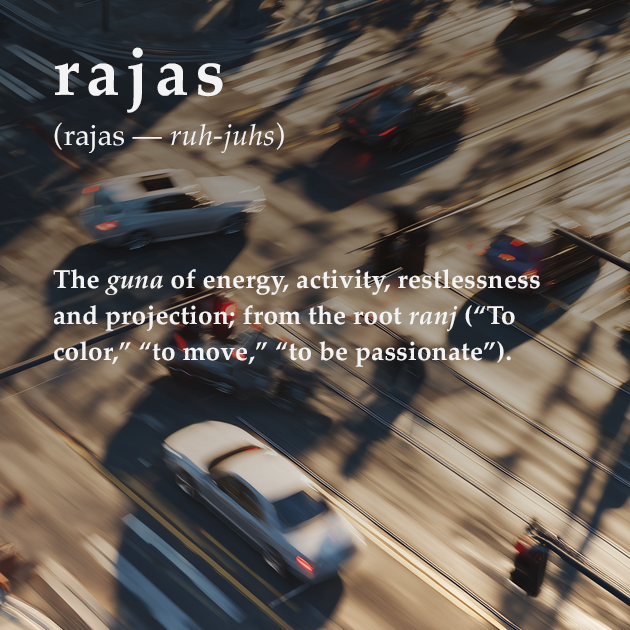Rajas - The Guna of Activity and Restlessness
- Daniel McKenzie

- Sep 11
- 2 min read
Updated: Dec 14

Rajas is one of the three gunas (sattva, rajas, tamas) that constitute prakriti, the fabric of the manifest world. Where sattva reflects clarity, harmony, and knowledge, and tamas conceals as inertia, rajas projects. It is the restless, dynamic force that drives activity, passion, and desire. Without rajas, nothing would move; with unchecked rajas, life becomes agitation.
In Vedanta, rajas is not condemned—it is necessary. Creation itself is the play of sattva, rajas, and tamas. Rajas animates the jiva’s striving: for wealth, relationships, recognition, power, or even spiritual highs. But it is also the source of dissatisfaction. Rajas is the fuel of becoming, always chasing what is not yet.
Rajasic devotion is outward, ego-driven, and transactional: praying for circumstances to align with one’s likes and dislikes. Even spiritual seekers may be rajasic when they pursue experiences rather than Self-knowledge. Thus, rajas, though a force of life, binds when it is allowed to dictate action without discrimination.
From a psychological standpoint, rajas manifests as restlessness, anxiety, competitiveness, ambition, frustration, and scattered energy. Its twin is fear, since every desire contains the fear of not attaining. rajas creates time and duality—the sense that fulfillment lies in the next achievement.
The solution in Vedanta is not suppression of rajas but mastery through karma yoga and inquiry. Rajasic tendencies are harnessed when subordinated to sattva: energy applied toward dharmic action, service, and Self-inquiry. Then rajas purifies instead of binding. Ultimately, freedom lies in recognizing that one is not the gunas but the Awareness in which they appear.
Root & Meaning
Rajas (from Sanskrit root rañj, “to color, to move, to be passionate”).
Meaning: activity, passion, restlessness, projection.
Scriptural References
Bhagavad Gita (14.7): “Rajas is of the nature of passion, the source of craving and attachment. It binds by attachment to action.”
Bhagavad Gita (3.37): identifies raga (desire) and krodha (anger) as born of rajas.
Mandukya Karika: explains rajas as the projecting power of maya, scattering awareness into multiplicity.
Traditional View
Rajas is one of the three gunas, responsible for activity and change.
Necessary for life and action, but binding when it fuels endless desire.
In spiritual practice, rajasic energy must be guided by dharma and transformed into sattva.
Vedantic Analysis
Rajas projects (vikshepa-shakti), creating distraction and discontent.
It expresses as desire, competition, ambition, and constant becoming.
When harnessed properly, it gives energy for sadhana and karma yoga.
Self-knowledge alone resolves rajas by revealing the Self as akarta, non-doer.
Common Misunderstandings
That rajas is “bad”: It is not evil but a necessary cosmic principle.
That spiritual life must eliminate rajas: In truth, rajas is refined and directed, not annihilated.
That rajasic devotion equals true bhakti: Real devotion is surrender, not bargaining.
Vedantic Resolution
Rajas, like all gunas, belongs to prakriti. The Self is gunatita, beyond them. Freedom comes by seeing rajas as part of the play of maya, not as “me.” Managed through dharma and inquiry, rajasic energy becomes a stepping-stone to liberation.
